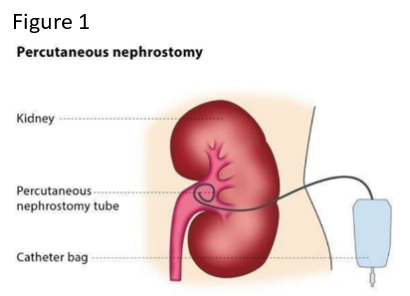The existing nephrostomy tube design, widely used for kidney drainage, presents challenges related to accidental premature extraction, necessitating resource-intensive replacement. We propose a novel modification to the standard design, which, unlike the conventional continuous tube design, consists of two distinct sections: a flexible tube that extends from the kidney anchor connected just outside the body to a second tube draining into the urine collection bag. This design ensures unimpeded urine flow and minimizes disruptions in cases of unintentional dislodgement. The user-friendly connection of the tubes promotes effortless reconnection, reducing the inconvenience and potential complications associated with tube replacement. Our solution maintains compatibility with existing materials and dimensions, enhancing its feasibility and implementation.
Nephrostomy tubes are vital in managing short- and long-term medical conditions, including ureteral obstructions due to benign and malignant tumors, impacted stones, infections, and ureteral strictures. These tubes are catheters placed directly through the flank into the kidney to drain urine (Figure 1). Their current designs of pigtail or Foley anchor, which aim to stabilize the tube within the kidney, makes them susceptible to dislodgement through sudden or steady tugging. This vulnerability leads to frequent premature extraction incidents, both accidental, as a result of everyday activities, or deliberate, particularly among patients with conditions such as dementia. Such removal can cause severe complications, including kidney damage. The strain on healthcare systems is substantial, with numerous emergency room visits and resource-intensive interventions required to address these incidents. Urgent and recurrent interventions and associated costs emphasize the unmet need to develop an innovative solution that ensures tube stability, reduces removal risks, and enhances patient safety while alleviating the burden on healthcare facilities.

A novel design consists of two parts: the first section extends from the kidney anchor outside the body, while the second section connects to the urine collection bag, providing an intuitive and efficient reconnection mechanism.
Prof. Berkowitz and Dr. Shilo designed a novel nephrostomy tube featuring two distinct sections and special connectors. The primary section extends from the kidney anchor outside the body, maintaining compatibility with existing tube dimensions and materials. The second section connects the primary section with the urine collection bag. This arrangement ensures uninterrupted urine drainage while mitigating the risk of premature dislodgement since, upon abrupt tugging, the tubes separate before any damage occurs to the kidney. The overlapping interface between the two sections allows for seamless reconnection, enhancing patient autonomy and minimizing the need for resource-intensive interventions.
- Prevention of Premature Extraction, thus reducing the need for emergency interventions and associated costs
- Ease of Reconnection that can be done by the patient, caregiver, or medical staff, minimizing downtime
- Maintained Drainage Efficiency, guaranteeing continued kidney functionality and patient comfort
- Compatibility with existing tube materials and dimensions, facilitating adoption across medical centers
This invention could potentially revolutionize nephrostomy tube management, improving patient safety and well-being and reducing the burden on healthcare facilities and providers. The demand for such a solution is substantial, given the widespread use of nephrostomy tubes across various medical conditions and patient demographics. Manufacturers, medical device companies, and healthcare providers stand to benefit from a product that enhances patient outcomes, streamlines operations and minimizes costs associated with preventable incidents. Moreover, as patient-centered care gains importance, a solution that empowers patients or caregivers to manage tube reconnection offers a unique selling point in the market.

Dr. Vered Pardo Yissar

